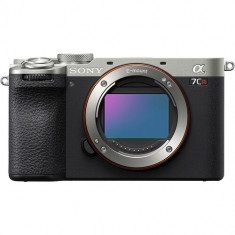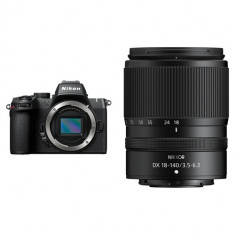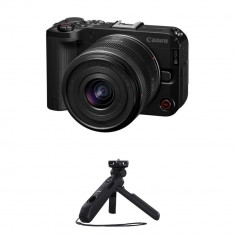Mirrorless
- 70 itemsFilters
Brand
-
24
-
19
-
27
Availability
-
46
-
67
-
70
Deals
-
17
Lens Mount
-
1
-
3
-
6
-
7
Monitor Size
-
10
-
4
-
9
-
6
-
2
Camera Format
-
32
-
16
Recording Modes
-
34
Pixels
-
4
-
4
-
7
-
11
-
4
-
5
Sensor Type
-
12
Sony a7CR Mirrorless Camera
SKU #000870 Model ILCE-7CR/BKey Features
- Shooting Up to 8 fps, ISO 50-102400
- 240.8MP Pixel Shift Multi Shooting
- BIONZ XR Image Processor
- 61MP Full-Frame Exmor R BSI Sensor
Canon EOS M50 Mark II Mirrorless Camera with 15-45mm Lens Vlogger Kit
SKU #105851 Model EOSM50MarkllVKKey Features
- 24.1MP APS-C CMOS Sensor
- DIGIC 8 Image Processor
- UHD 4K and HD 720p120 Video Recording
- Dual Pixel CMOS AF with Eye Detect AF
Sony a9 III Mirrorless Camera
SKU #000917 Model ILCE-9M3Key Features
- 24.6MP Full-Frame Global Shutter Sensor
- Up to 120 fps Cont. Shooting with AF/AE
- Flash Sync at up to 1/80,000 Sec.
- Pre-Capture Function; Speed Boost Button
Nikon Z50 Mirrorless Camera
SKU #110036 Model 1634Key Features
- 20.9MP DX-Format CMOS Sensor
- EXPEED 6 Image Processor
- 2.36m-Dot OLED Electronic Viewfinder
Canon EOS R5 Mark II Mirrorless Camera
SKU #110178 Model 6536C002Key Features
- 45MP Full-Frame Stacked BSI CMOS Sensor
- DIGIC Accelerator Processing
- Dual Pixel Intelligent AF, Eye Control
- 8K 60 Raw/4K 60 SRAW/4K 120 10-Bit Video

Sony a7C II Mirrorless Camera Silver (Body Only)
SKU #000905 Model ILCE-7CM2Key Features
- 33MP Full-Frame Exmor R BSI Sensor
- BIONZ XR Image Processor
- Shooting Up to 10 fps, ISO 50-204800
- 10-Bit Full-Frame 4K30p Video

Sony a7CR Mirrorless Camera (Silver)
SKU #000955 Model ILCE-7CR/SKey Features
- 61MP Full-Frame Exmor R BSI Sensor
- BIONZ XR Image Processor
- 240.8MP Pixel Shift Multi Shooting
- Shooting Up to 8 fps, ISO 50-102400
Nikon Z50 II Mirrorless Camera with 18-140mm f/3.5-6.3 Lens Kit
SKU #110308 Model NIZ5021814LKKey Features
- 20.9MP DX-Format CMOS Sensor
- EXPEED 7 Image Processor
- Improved Autofocus, 9 Subject Detection
- UHD 4K60p/Full HD 120fps Video Recording

Canon EOS R50 V Mirrorless Camera with Canon RF-S 14-30mm Lens & Tripod Grip
SKU #110476S1 Model 6895C002Key Features
- For Content Creators and Vloggers
- 24.2MP APS-C CMOS Sensor
- DIGIC X Image Processor
- UHD 4K60p Cropped, 4K30 6K Oversampled
Nikon Z5 II Mirrorless Camera with Nikon NIKKOR Z 24-50mm Lens
SKU #110475S01 Model 1680Key Features
- 24.5MP FX-Format CMOS Sensor
- EXPEED 7 Image Processor
- ISO 100-64000, Up to 30 fps Shooting
- UHD 4K and Full HD Video Recording
Mirrorless
A mirrorless camera is a digital interchangeable lens camera. Unlike a DLSR, a mirrorless camera lacks a swinging mirror and optical viewfinder. Instead, the light passing through the lens hits the sensor directly, transmits the preview image to an electronic viewfinder (EVF) or the main LCD screen. This allows for mirrorless cameras to be significantly smaller and lighter than DLSRs, among other things.
Mirrorless Cameras
1) What is a mirrorless camera?
A mirrorless camera is a digital interchangeable lens camera. Unlike a DLSR, a mirrorless camera lacks a swinging mirror and optical viewfinder. Instead, the light passing through the lens hits the sensor directly, transmits the preview image to an electronic viewfinder (EVF) or the main LCD screen. This allows for mirrorless cameras to be significantly smaller and lighter than DLSRs, among other things.
2) What does ISO mean?
Photographically, ISO stands for the level of sensitivity the camera’s sensor has to light. The higher the ISO number, the more sensitive the sensor and the brighter the image. ISO is an adjustable setting and reaches much higher than it ever did. However, very high ISO settings can sometimes cause grain or “noise” in the image.
When a camera is said to be “very good in low light” it means that there is little to no noise in the higher ISO values.
3) What is a megapixel?
A camera’s sensor is comprised of millions of individual pixels (for “picture element”). Each pixel works individually to capture a tiny amount of light and color, which then gets combined to form the final image. One million of these pixels equals one megapixel. The number of megapixels determines the resolution of the image, and in turn how large the image can be printed or how much it can be cropped. The more megapixels, the larger your prints can be.











